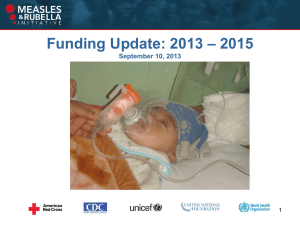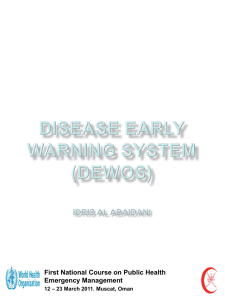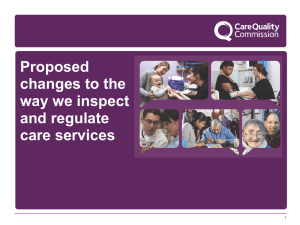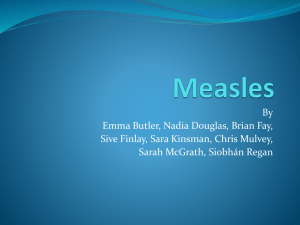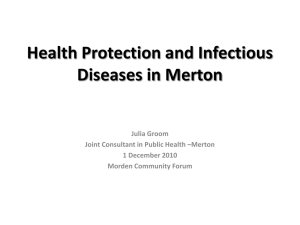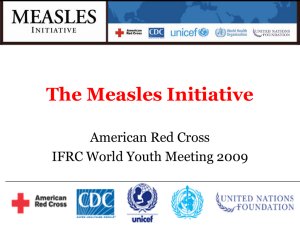Surveillance at the district level
advertisement
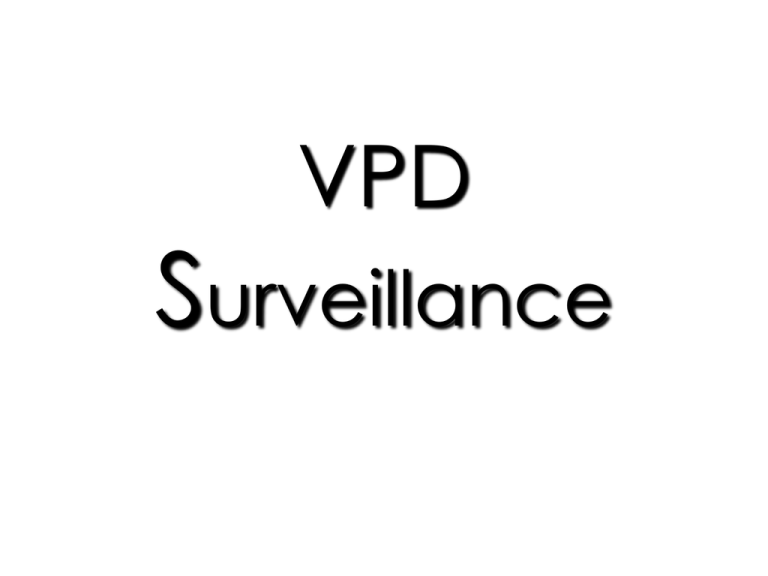
VPD Surveillance Surveillance is the … Ongoing systematic collection, collation, and analysis of health data and the dissemination of that information to those who need to know so appropriate action can be taken Surveillance is the continued vigil over the occurrence and distribution of disease and conditions which increase the risk of disease transmission Surveillance is information for action A surveillance system should: •Describe each person having an infection or disease •Determine source of infection and mode of transmission •Identify exposed, susceptible person to whom the infection may have been transmitted •Specify frequency of occurrence of infection in different population groups •Prepare and distribute surveillance reports A major objective of disease surveillance is… To determine the extent of infections and the risk of disease transmission …so control measures can be applied effectively and disease can be prevented Five functions of a surveillance system •Case detection and notification •Investigation and confirmation •Data collection and consolidation •Data analysis •Information dissemination All done to guide public health action Additional supporting functions of disease surveillance: • Setting standards (e.g case definition) • Training and supervision • Setting up laboratory support • Establishing communication network • Optimizing resource management • Improve coordination/integration Surveillance tasks differ depending upon the level District level Provincial level Central or National level Surveillance at the district level • Diagnosis and case management • Reporting of cases • Simple tabulation and graphing of data Surveillance at the Provincial level • Case management for more difficult cases • Analyze data from peripheral level for epidemiological links and trends • Monitor data to check if control targets have been met • Investigate suspected outbreaks. • Feed back to the district • Report to central level Surveillance at the National level • overall support and coordination of national surveillance activities. • provision of laboratory diagnosis data •analyze data from intermediate level for: • epidemiological links • trends • achievement of control targets. • support intermediate level for outbreak control •feed back to intermediate level, and report to WHO regional office Information gathered from Disease Surveillance can be used to… • Estimate the magnitude of health problem • Determine geographic distribution • Portray natural history of a disease • Detect epidemics • Monitor changes in infectious agents • Evaluate control measures • Facilitate and improve planning • Generate hypothesis and stimulate research Sources of data for surveillance • Notifiable disease reports • Laboratory results • Vital records • Sentinel surveillance • Birth/death registries • Surveys •Vaccine utilization records • Vaccine adverse event reporting system Types of surveillance Passive surveillance: data are routinely collected and forwarded to more central levels Active surveillance: data are sought out by visiting or contacting a reporting site Comprehensive surveillance: data are collected from numerous sites throughout a country in order to achieve representation of whole population Sentinel surveillance: selected sites report data, can be used to monitor trends and collect detailed information, but may not represent the entire country Community-based, facility-based and laboratory-based surveillance: involve detection and notification by communities, health facilities and laboratories Prioritize which diseases need surveillance, diseases: • does the disease result in a high disease impact? (morbidity, mortality, disability) • does the disease have a significant epidemic potential (cholera, measles) • is the disease a specific target of a national / international control program • will the collected information lead to significant public health action? What needs to be addressed for each disease under surveillance? •The case definition should be •Clear • Appropriate • Consistent throughout the surveillance system • The reporting mechanism should be • Clear • Efficient • Appropriate reporting periodicity • Available to all relevant persons •The analysis of data should be • Appropriate • Allow for proper presentation • Used for decision-making • The people doing the surveillance should • Have a good understanding of the value of surveillance system • Understand their surveillance task • Have sufficient resources • The personnel involved should receive appropriate • Training • Supervision • The feed-back from central levels should be • Appropriate in format • Sufficient and frequent enough • Motivating Objectives of Measles Surveillance in Pakistan • Estimate disease burden • Detect and characterize cases • Detect and Investigate outbreaks • Identify populations at risk • Monitor program activities • Evaluate and guide policy Basic Epidemiology • Measles virus is RNA virus of the genus Morbillivirus, a member of the Paramyxoviridae family • Exclusively human pathogen, no animal reservoir, no vector • Transmitted by respiratory droplets, via aerosol and direct contact • Average incubation period (from exposure to rash onset) is 14 days (range 7 – 18 days) • Patients are contagious from 2 – 3 days before until 1 – 2 days after rash onset Main Characteristics • Two components – Routine Weekly Reporting – Outbreak Detection and Investigation Routine Weekly Reporting • Case-based – Investigation of every suspected measles cases using standard Case Investigation Form (CIF) with blood specimen collection for confirmation of diagnosis – Weekly reporting of all suspected measles cases • Facility-based – All government facilities and – Private facilities included in weekly AFP zero reporting • Laboratory Component – IgM verification of all suspected cases Identification of Measles Suspected Cases • Patients presenting at health facility satisfying case definition • Patient with history of measles (satisfying case definition) and presenting common complications of measles within past one month at health facility Measles Case Definition Algorithm Yes No Did the person have maculo-papular rash? No Did the person have fever? Yes Not Measles Not Measles Did the person have any of the followings? Yes Cough No Yes Running nose Measles No Yes Red eye Measles Yes Measles No Not Measles Action Points – Health Facility Suspected Measles Case • Record patient’s details in Measles Case Investigation Form (CIF) • Arrange collection of blood specimen (3-5 ml) for IgM test • Label specimen and record type and date of specimen collection in the measles CIF • Sent specimen to EDO (Health) office in reverse cold chain along with a copy of CIF • At the end of week (Saturday), compile all suspected cases in weekly report (Form B) and send to EDO (Health) office. • IF NO CASES FOUND DURING THE WEEK, ZERO REPORT MUST BE SENT Action Points - District Level • Gather weekly reports (Form B) from all reporting health facilities • Assign EPID Number to all suspected cases • Prepare weekly district compilation report – Take data from weekly reports from health facilities and – Case Investigation Form • Separate serum from the whole blood specimen sent from health facilities (if not done already) • Transship specimen collected from health facilities to National Measles Laboratory at NIH Islamabad with EPID number on it’s sticker Contd: Action Points - District Level • Check for outbreaks (see below in Outbreak Investigation) • Analyze data (see below in Reporting) – Epidemiology – System indicators Send compilation report to provincial EPI office by Tuesday EPID Number - Suspected Case • District Surveillance Coordinators (DSC) will allocate an unique EPID number to each suspected case with the following format: • Country code/Province Code/District ID/ Year/Msl/Case Serial # # # # • EPID Number on: – CIF – Compilation report – Sticker on specimen Trigger for Outbreak Investigation • More than 5 suspected measles cases from one first level health care facility (RHC and below) in one week OR • More than 5 suspected measles cases in a higher level facility coming from one geographical area OR • Report of more than 5 suspected measles cases in one area by trained LHW Initial Outbreak Confirmation • DSC with support of SO-WHO to confirm outbreak by visiting affected area (initial phase) – Through community assessment with the goal to find cases in the past 30 days – Arrange collection of at least 5 blood samples if already not done • If confirmed – Form investigation team Definition of Measles Outbreak • More than 5 suspected measles cases including at least one laboratory confirmed measles case in the identified area during the recall period of 30 days prior to investigation. Thank you

